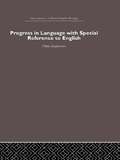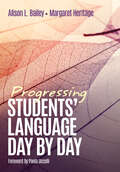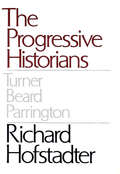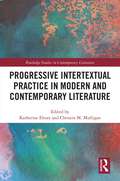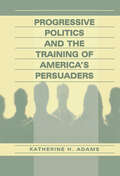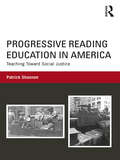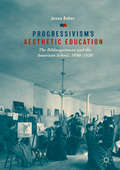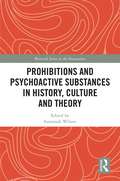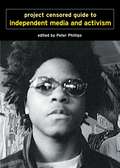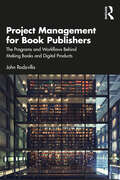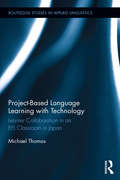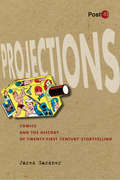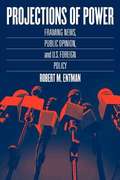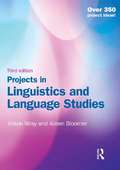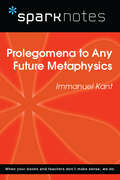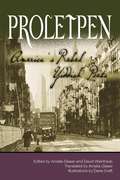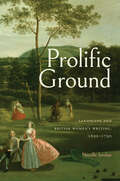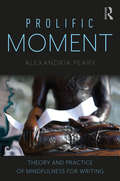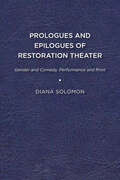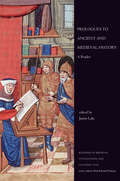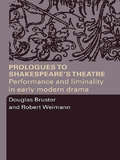- Table View
- List View
Progress in Language, with special reference to English
by Otto JespersenFirst published in 2006. Routledge is an imprint of Taylor & Francis, an informa company.
Progress: A Personal Journey in Feminism
by Katharine Graham Katharine WeymouthAn eBook short.From Katharine Graham's Pulitzer Prize-winning memoir Personal History, a stirring narrative of how the legendary publisher of the Washington Post became a feminist. With an introduction from her granddaughter, Katharine Weymouth, publisher of the Post until 2014. Katharine Graham was the newspaper mogul who piloted the Washington Post through the crises of the Pentagon Papers and Watergate: but first she had to overcome the harsh expectations of a male-dominated industry, and her harshest critic of all--herself. Inheriting ownership of the paper from her father, and assuming its leadership in 1963 after the death of her husband, Philip, Graham found herself the only woman in a man's world--a world, however, that was beginning to change. From Georgetown suppers to board meetings, from The Second Sex to Gloria Steinem, this is the refreshingly honest account of how the most powerful woman in Washington came into her own.
Progressing Students′ Language Day by Day
by Margaret Heritage Alison L. BaileyBecause content and language learning go hand in hand New content standards integrate content and language in ways prior standards have never done. That’s why it’s so critically important that teachers attend to both content and language development when introducing new subject matter, especially for English learners. Here’s your opportunity to get started tomorrow and every day thereafter: Alison Bailey and Margaret Heritage’s all-new Progressing Students’ Language Day by Day. What’s so utterly ground-breaking about this book is Bailey and Heritage’s Dynamic Language Learning Progression (DLLP) process: research-based tools for obtaining much deeper insight into a student’s language progress, then for identifying the most appropriate instructional steps to elevate language proficiency and content knowledge. Step by step, Bailey and Heritage describe how to Engage with students to advance their development of sophisticated, high-leverage language features for explaining content Use the DLLP approach to formative assessment, then plan your teaching in response to assessment evidence Examine words, sentences, and discourse --the three dimensions of language that are part of the DLLP process for cultivating language development Discover how leadership support and communities of practice (CoPs) can facilitate a successful and sustainable implementation of the DLLP process Listen more closely and uncover new ways to advance content learning with Progressing Students’ Language Day by Day directly by your side. "Alison Bailey and Margaret Heritage open our eyes to the often invisible and context-specific language demands embedded in content learning. Understanding the ubiq¬uitous and highly influential role of language in learning takes time and effort but leads to transformative practice. Progressing Students’ Language Learning Day by Day offers an insightful and concrete framework to begin this transformation." — Paola Uccelli, Professor of Education, Harvard University
Progressing Students′ Language Day by Day
by Margaret Heritage Alison L. BaileyBecause content and language learning go hand in hand New content standards integrate content and language in ways prior standards have never done. That’s why it’s so critically important that teachers attend to both content and language development when introducing new subject matter, especially for English learners. Here’s your opportunity to get started tomorrow and every day thereafter: Alison Bailey and Margaret Heritage’s all-new Progressing Students’ Language Day by Day. What’s so utterly ground-breaking about this book is Bailey and Heritage’s Dynamic Language Learning Progression (DLLP) process: research-based tools for obtaining much deeper insight into a student’s language progress, then for identifying the most appropriate instructional steps to elevate language proficiency and content knowledge. Step by step, Bailey and Heritage describe how to Engage with students to advance their development of sophisticated, high-leverage language features for explaining content Use the DLLP approach to formative assessment, then plan your teaching in response to assessment evidence Examine words, sentences, and discourse --the three dimensions of language that are part of the DLLP process for cultivating language development Discover how leadership support and communities of practice (CoPs) can facilitate a successful and sustainable implementation of the DLLP process Listen more closely and uncover new ways to advance content learning with Progressing Students’ Language Day by Day directly by your side. "Alison Bailey and Margaret Heritage open our eyes to the often invisible and context-specific language demands embedded in content learning. Understanding the ubiq¬uitous and highly influential role of language in learning takes time and effort but leads to transformative practice. Progressing Students’ Language Learning Day by Day offers an insightful and concrete framework to begin this transformation." — Paola Uccelli, Professor of Education, Harvard University
Progressive Intertextual Practice In Modern And Contemporary Literature (Routledge Studies in Contemporary Literature)
by Katherine Ebury Christin M. MulliganThis edited volume aims to reposition intertextuality in relation to recent trends in critical practice. Inspired by the work of Sara Ahmed in particular, our authors explore and reconfigure classic theories of authorship, influence and the text (including those by Roland Barthes, Michel Foucault and Harold Bloom), updating these conversations to include intersectionality specifically, broadly understood to include gendered, racial and other forms of social justice including disability, and the progressive impact of the transmission and transformation of texts. This diverse volume includes discussions of major canonical works such as James Joyce’s Ulysses alongside the recent contemporary literature by authors such as Siri Husvedt and Maggie O’Farrell, as well as theoretical interventions. This volume also engages with how intertextuality can facilitate interdisciplinary and ekphrastic thinking and representation, as the inspiration of music and the visual arts for texts and their transmission is addressed. The choice of intertexts become deliberately political, ethical and artistic signifiers for the authors discussed in this volume, and our contributors are thus enabled to address topics ranging from visual impairment to Shakespearean motherhood to the influence of Jazz culture on writing on the Northern Irish Troubles.
Progressive Politics and the Training of America's Persuaders
by Katherine AdamsAt the beginning of the 20th century, Progressive reformers set up curricula in journalism, public relations, and creative writing to fulfill their own purposes: well-trained rhetors could convince the United States citizenry to accept Progressive thinking on monopolies and unions and to elect reform candidates. Although Progressive politicians and educators envisioned these courses and majors as forwarding their own goals, they could not control the intentions of the graduates thus trained or the employers who hired them. The period's vast panorama of rhetoric, including Theodore Roosevelt's publicity stunts, muckraker exposés, ad campaigns for patent medicines, and the selling of World War I, revealed the new national power of propaganda and the media, especially when wielded by college-trained experts imbued with the Progressive tradition of serving a cause and ensuring social betterment. In this unique volume, Adams' chronicles the creation of this advanced curriculum in speaking and writing during the Progressive era and examines the impact of that curriculum on public discourse. Unlike other studies of writing instruction, which have concentrated on freshman curriculum or on a specific genre, this book provides a historical and cultural analysis of the advanced composition curriculum and of its impact on public persuasion. Adams surveys American instruction at state and private schools across the country, with special attention given to the influential Progressive universities of the Midwest. She draws on a wide variety of primary data sources including college catalogs, course assignments, departmental minutes, speeches, and journals, and includes an extensive bibliography of research sources concerning advanced composition instruction and American rhetoric before World War II. As a resource offering remarkable historical insights on the history of writing instruction in America, this volume is of great interest to scholars and students in rhetoric, communication, and technical writing.
Progressive Reading Education in America: Teaching Toward Social Justice
by Patrick ShannonThrough firsthand accounts of classroom practices, this new book ties 130 years of progressive education to social justice work. Based on their commitments to the principle of the equal moral worth of all people, progressive teachers have challenged the obstacles of schooling that prevent some people from participating as full partners in social life in and out of the classroom and have constructed classroom and social arrangements that enable all to participate as peers in the decisions that influence their lives. Progressive reading education has been and remains key to these ties, commitments, challenges, and constructions. The three goals in this book are to show that there are viable and worthy alternatives to the current version of "doing school"; to provide evidence of how progressive teachers have accommodated expanding notions of social justice across time, taking up issues of economic distribution of resources during the first half of the 20th century, adding the cultural recognition of the civil rights of more groups during the second half, and now, grappling with political representation of groups and individuals as national boundaries become porous; and to build coalitions around social justice work among advocates of differing, but complementary, theories and practices of literacy work. In progressive classrooms from Harlem to Los Angeles and Milwaukee to Fairhope, Alabama, students have used reading in order to make sense of and sense in changing times, working across economic, cultural, and political dimensions of social justice. Over 100 teacher stories invite readers to join the struggle to continue the pursuit of a just democracy in America.
Progressivism's Aesthetic Education: The Bildungsroman and the American School, 1890–1920
by Jesse RaberDuring the Progressive Era in the United States, as teaching became professionalized and compulsory attendance laws were passed, the public school emerged as a cultural authority. What did accepting this authority mean for Americans’ conception of self-government and their freedom of thought? And what did it mean for the role of artists and intellectuals within democratic society? Jesse Raber argues that the bildungsroman negotiated this tension between democratic autonomy and cultural authority, reprising an old role for the genre in a new social and intellectual context. Considering novels by Abraham Cahan, Willa Cather, and Charlotte Perkins Gilman alongside the educational thought of John Dewey, the Montessorians, the American Herbartians, and the social efficiency educators, Raber traces the development of an aesthetics of social action. Richly sourced and vividly narrated, this book is a creative intervention in the fields of literary criticism, pragmatic philosophy, aesthetic theory, and the history of education.
Prohibitions and Psychoactive Substances in History, Culture and Theory: Prohibitions and Psychoactive Substances (Warwick Series in the Humanities)
by Susannah WilsonThis volume is a new contribution to the dynamic scholarly discussion of the control and regulation of psychoactive substances in culture and society. Offering new critical reflections on the reasons prohibitions have historically arisen, the book analyses "prohibitions" as ambivalent and tenuous interactions between the users of psychoactive substances and regulators of their use. This original collection of essays engages with contemporary debates concerning addiction, intoxication and drug regulation, and will be of interest to scholars in the arts, humanities and social sciences interested in narratives of prohibition and their social and cultural meanings.
Project Censored Guide to Independent Media and Activism (Open Media Series)
by Peter PhillipsThe independent media are arguably more important than ever today, as corporate media's line reads increasingly like a government press release rather than a free society's analysis of the day's important events. But there's a lot to sort through: Independent newsmagazines and newspapers, local cable-TV access, and independent and microtransmitted radio are everywhere, offering a vast array of news, opinions, and information. New Indymedia activists alone now have direct links to more than sixty-five grassroots news sites around the world. The challenge we are faced with is two-fold: We must make these news sources widely accessible, but we must also find ways to compile, sort, and collectively release this real news to millions of people--a project that this invaluable guide for diversifying your access to information can make much more achievable.
Project Management for Book Publishers: The Programs and Workflows Behind Making Books and Digital Products
by John RodzvillaProject Management for Book Publishers provides readers with a solid understanding of efficient processes and workflows for content creation, product development, and the marketing and distribution of both physical and digital products.Digital has brought more data, more training, and more accountability to the publishing process. But it has also shone light on how systems designed initially around print-first publications are ill-equipped to support an industry of now would-be digital media companies. This book addresses some of the major challenges for publishing houses facing this reality, including how to create a digital-aware workflow, implementing quality assurance procedures, and using different management systems to develop an efficient workflow. Beginning by explaining project and product management practices used throughout technology and media companies, it then delves into when and how these principles can be applied to the publishing workflow. Topics covered include Waterfall and Agile Project Management, Scrum methodology, Kanban framework, ebook and audio formats, metadata, quality assurance, crowdfunding, in-app monetization, ONIX, and accessibility. Readers will consider not just how to contend with online platforms that allow authors to publish with the click of a button, and audiences accustomed to accessing content across multiple platforms and formats, but also challenges arising from factors such as the data-driven acquisitions model in libraries, the downward spiral of sales in college bookstores, the call for accessibility, and the need for fluid content systems that can work with different publishing databases and software.Written for publishing professionals at all levels, this book will also help advanced students of Publishing and Book Studies navigate best practices for project management in the modern publishing landscape.
Project-Based Language Learning with Technology: Learner Collaboration in an EFL Classroom in Japan (Routledge Studies in Applied Linguistics)
by Michael ThomasThis book highlights the ways in which insights from technology-mediated project-based language learning research can contribute to our understanding of both learner interaction in specific cultural contexts but also of the role of technology in language learning more generally. The volume situates the discussion within the context of the development of the field, from task-based to project-based language learning, and how these have been shaped over time by the evolution of new technologies. Using the case study of EFL learners in a Japanese classroom, the book adopts a multimodal approach to unpack this phenomena at work by examining learner collaboration in project-based work in a real-world setting. The volume provides a valuable contribution to the ongoing debate about the effective integration of digital technologies in the classroom and will be of particular interest to students and scholars in applied linguistics, computer-assisted language learning, task-based language teaching, and TESOL.
Projecting the Adjective: The Syntax and Semantics of Gradability and Comparison (Outstanding Dissertations in Linguistics)
by Christopher KennedyFirst Published in 1999. Routledge is an imprint of Taylor & Francis, an informa company.
Projections
by Jared GardnerWhen Art Spiegelman's Maus won the Pulitzer Prize in 1992, it marked a new era for comics. Comics are now taken seriously by the same academic and cultural institutions that long dismissed the form. And the visibility of comics continues to increase, with alternative cartoonists now published by major presses and more comics-based films arriving on the screen each year. Projections argues that the seemingly sudden visibility of comics is no accident. Beginning with the parallel development of narrative comics at the turn of the 20th century, comics have long been a form that invites—indeed requires—readers to help shape the stories being told. Today, with the rise of interactive media, the creative techniques and the reading practices comics have been experimenting with for a century are now in universal demand. Recounting the history of comics from the nineteenth-century rise of sequential comics to the newspaper strip, through comic books and underground comix, to the graphic novel and webcomics, Gardner shows why they offer the best models for rethinking storytelling in the twenty-first century. In the process, he reminds us of some beloved characters from our past and present, including Happy Hooligan, Krazy Kat, Crypt Keeper, and Mr. Natural.
Projections of Power: Framing News, Public Opinion, and U.S. Foreign Policy
by Robert M. EntmanTo succeed in foreign policy, U.S. presidents have to sell their versions or framings of political events to the news media and to the public. But since the end of the Cold War, journalists have increasingly resisted presidential views, even offering their own spin on events. What, then, determines whether the media will accept or reject the White House perspective? And what consequences does this new media environment have for policymaking and public opinion? To answer these questions, Robert M. Entman develops a powerful new model of how media framing works -- a model that allows him to explain why the media cheered American victories over small-time dictators in Grenada and Panama but barely noticed the success of far more difficult missions in Haiti and Kosovo. Discussing the practical implications of his model, Entman also suggests ways to more effectively encourage the exchange of ideas between the government and the media and between the media and the public. His book will be an essential guide for political scientists, students of the media, and anyone interested in the increasingly influential role of the media in foreign policy.
Projects in Linguistics and Language Studies
by Alison Wray Aileen BloomerProjects in Linguistics and Language Studies, Third Edition, is your essential guide when embarking on a research project in linguistics or English language.It is clearly divided into the subject areas that most appeal to you as a student: psycholinguistics; first- and second-language acquisition; structure and meaning; sociolinguistics; language and gender; accents and dialects; and the history of English. New chapters on researching computer-mediated communication (CMC) and on preparing and delivering oral presentations are also included.It offers practical advice on - identifying a topic - making background reading more effective - planning and designing a project - collecting and analysing data - writing up and presenting findings.With over 350 project ideas that you can use directly or adapt to suit different contexts and interests, and with chapters on how to reference effectively and how to avoid plagiarism, this third edition of Projects in Linguistics and Language Studies is a reference guide that you will use again and again during your studies.
Prolegomena to Any Future Metaphysics (SparkNotes Philosophy Guide)
by SparkNotesProlegomena to Any Future Metaphysics (SparkNotes Philosophy Guide) Making the reading experience fun! SparkNotes Philosophy Guides are one-stop guides to the great works of philosophy–masterpieces that stand at the foundations of Western thought. Inside each Philosophy Guide you&’ll find insightful overviews of great philosophical works of the Western world.
Prolegomenon to a Theory of Argument Structure
by Kenneth L. Hale Samuel Jay KeyserThis work is the culmination of an eighteen-year collaboration between Ken Hale and Samuel Jay Keyser on the study of the syntax of lexical items. It examines the hypothesis that the behavior of lexical items may be explained in terms of a very small number of very simple principles. In particular, a lexical item is assumed to project a syntactic configuration defined over just two relations, complement and specifier, where these configurations are constrained to preclude iteration and to permit only binary branching. The work examines this hypothesis by methodically looking at a variety of constructions in English and other languages.
Proletpen
by Amelia Glaser David WeintraubIn the original with English translation on facing pages, Glaser (Judaic studies, U. of Pennsylvania) presents Yiddish poetry written by American proletarian writers who identified politically and poetically with the American Left from the 1920s to the early 1950s. McCarthy-era political correctness drove the poets and their work from the burgeoning Yiddish canon. Annotation ©2006 Book News, Inc. , Portland, OR (booknews. com)
Prolific Ground: Landscape and British Women's Writing, 1690–1790 (Transits: Literature, Thought & Culture, 1650-1850)
by Nicolle JordanLand ownership—and engagement with land more generally—constituted a crucial dimension of female independence in eighteenth-century Britain. Because political citizenship was restricted to male property owners, women could not wield political power in the way propertied men did. Given its foundational sociopolitical function, land necessarily generated copious writing that vested it with considerable aesthetic and economic value. This book, then, situates these issues in relation to the historical transformation of landscape under emergent capitalism. The women writers featured herein—including Jane Barker, Anne Finch, Sarah Scott, and Elizabeth Montagu—participated in this transformation by celebrating female estate stewardship and evaluating the estate stewardship of men. By asserting their authority in such matters, these writers acquired a degree of independence and self-determination that otherwise proved elusive.
Prolific Moment: Theory and Practice of Mindfulness for Writing
by Alexandria PearyProlific Moment: Theory and Practice of Mindfulness for Writing foregrounds the present in all activities of composing, offering a new perspective on the rhetorical situation and the writing process. A focus on the present casts light on standard writing components—audience, invention, and revision—while bringing forth often overlooked nuances of the writing experience—intrapersonal rhetoric, the preverbal, and preconception. This pedagogy of mindful writing can alleviate the suffering of writing blocks that comes from mindless, future-oriented rhetorics. Much is lost with a misplaced present moment because students forfeit rewarding writing experiences for stress, frustration, boredom, fear, and shortchanged invention. Writing becomes a very different experience if students think of it more consistently as part of a discrete now. Peary examines mindfulness as a metacognitive practice and turns to foundational Buddhist concepts of no-self, emptiness, impermanence, and detachment for methods for observing the moment in the writing classroom. This volume is a fantastic resource for future and current instructors and scholars of composition, rhetoric, and writing studies.
Prologues and Epilogues of Restoration Theater: Gender and Comedy, Performance and Print
by Diana SolomonOften perceived as merely formulaic or historical documents, dramatic prologues and epilogues – players’ comic, poetic bids for the audience’s good opinion – became essential parts of Restoration theater, appearing in over 90 percent of performed and printed plays between 1660 and 1714. Their popularity coincided with the rise of the English actress, and Prologues and Epilogues of Restoration Theater unites these elements in the first book-length study on the subject. It finds that these paratexts provided the first sanctioned space for actresses in Britain to voice ideas in public, communicate directly with other women, and perform comedy – arguably the most powerful type of speech, and one that enabled interrogation of misogynist social practices. This book provides a taxonomy of prologues and epilogues with a corresponding appendix, and demonstrates through case studies of Anne Bracegirdle and Anne Oldfield how the study of prologues and epilogues enriches Restoration theater scholarship. Published by University of Delaware Press. Distributed worldwide by Rutgers University Press.
Prologues to Ancient and Medieval History: A Reader (Readings in Medieval Civilizations and Cultures #17)
by Justin LakeThe purpose of a prologue in the ancient and medieval world was to define the subject of the work, explain the author's motives and methodology, and obtain the reader's approval of his position. This volume brings together for the first time the most important historical prologues of the European tradition for a period of almost two millennia. The volume consists of more than 80 historical prologues and prefatory epistles from the fifth century BC to the fourteenth century. Each individual prologue is preceded by a brief introduction that provides basic information and context about the author and his work and directs the reader's attention to important ideas and themes. Taken together, they help to bridge the gap that separates the ancient and medieval world from our own.
Prologues to Shakespeare's Theatre: Performance and Liminality in Early Modern Drama
by Douglas Bruster Robert WeimannThis eye-opening study draws attention to the largely neglected form of the early modern prologue. Reading the prologue in performed as well as printed contexts, Douglas Bruster and Robert Weimann take us beyond concepts of stability and autonomy in dramatic beginnings to reveal the crucial cultural functions performed by the prologue in Elizabethan England.While its most basic task is to seize the attention of a noisy audience, the prologue's more significant threshold position is used to usher spectators and actors through a rite of passage. Engaging competing claims, expectations and offerings, the prologue introduces, authorizes and, critically, straddles the worlds of the actual theatrical event and the 'counterfeit' world on stage. In this way, prologues occupy a unique and powerful position between two orders of cultural practice and perception.Close readings of prologues by Shakespeare and his contemporaries, including Marlowe, Peele and Lyly, demonstrate the prologue's role in representing both the world in the play and playing in the world. Through their detailed examination of this remarkable form and its functions, the authors provide a fascinating perspective on early modern drama, a perspective that enriches our knowledge of the plays' socio-cultural context and their mode of theatrical address and action.
